Format Bar Gauge
The Format Bar Gauge dialog helps you to format a bar gauge chart. It contains the following tabs: Staff Graph, Axis, Pointer, Target, Frame, Range Color and Hint.
OK
Applies the changes and closes the dialog.
Cancel
Does not retain any changes and closes the dialog.
Help
Displays the help document about this feature.
Staff Graph
Specifies the properties for bars in the bar gauge.
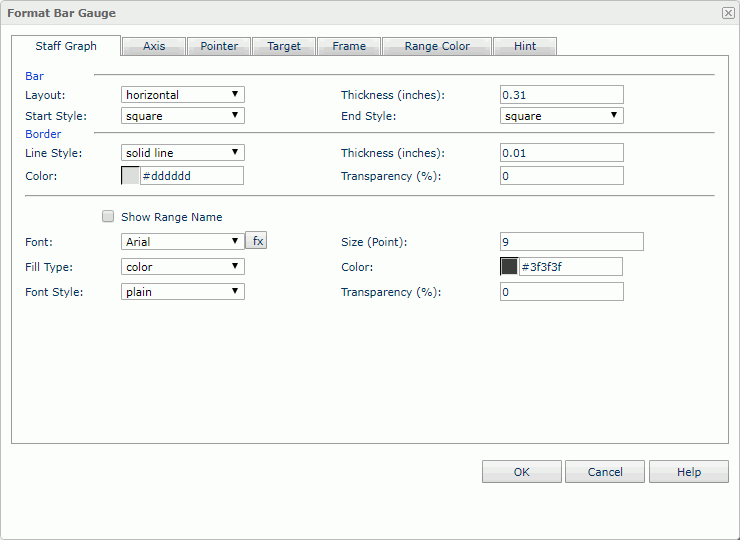
Bar
Specifies the properties of the bars.
- Layout
Specifies the layout of the bars. It can be vertical or horizontal. - Thickness
Specifies the thickness of the bars, in inches. - Start Style
Specifies the style for the start graph of the bars. - End Style
Specifies the style for the end graph of the bars.
Border
Specifies properties of the bar border.
- Line Style
Specifies the line style of the border. - Thickness
Specifies the thickness of the border, in inches. - Color
Specifies the color of the border. To change the color, select the color indicator to specify a new color in the Select Color dialog, or input a color string in the format #RRGGBB. If you want to make the background transparent, input Transparent in the text box. - Transparency
Specifies the transparency for the border color.
Show Range Name
Specifies whether to show the names of the ranges defined in the Range Color tab. When it is checked you can continue to specify the font properties of the text in the range names.
- Font
Lists all the available font faces that can be selected to apply to the text. - Size
Specifies the font size of the text. - Fill Type
Specifies the fill type of the text. It can be one of the following: none, color, gradient and texture. - Color
Specifies the font color of the text. - Font Style
Specifies the font style of the text. It can be one of the following: plain, bold, italic, and bold italic. - Transparency
Specifies the color transparency of the text.
Axis
The tab consists of four sub tabs: Axis, Tick Mark, Label and Format.
Axis
Specifies properties of the axis in the bar gauge.
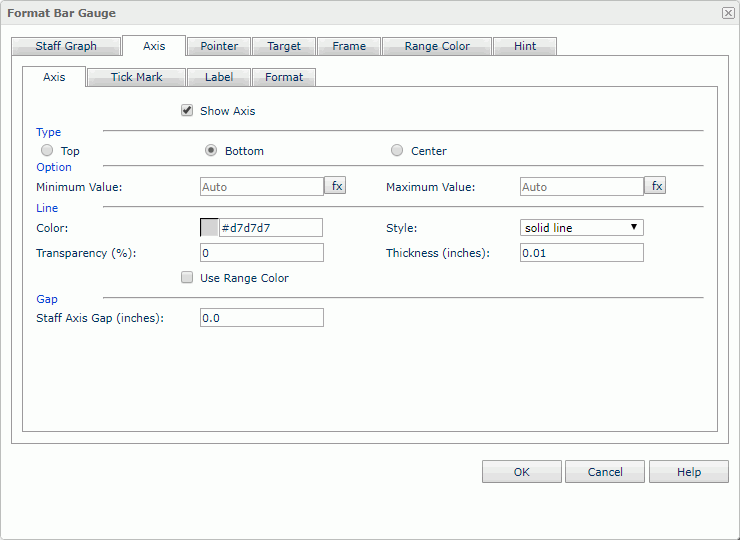
Show Axis
Specifies whether to show the axis.
Type
Specifies the position relationship of the axis and the bar. When Layout is set to horizontal in the Staff Graph tab, the following are available:
- Top
The axis will be on the top of the bar. - Bottom
The axis will be on the bottom of the bar. - Center
The axis will be in the center of the bar.
When Layout is set to vertical in the Staff Graph tab, the following are available:
- Left
The axis will be on the left of the bar. - Right
The axis will be on the right of the bar. - Center
The axis will be in the center of the bar.
Option
Specifies the values to be displayed in the chart.
- Minimum Value
Specifies the minimum value to be displayed in the chart. - Maximum Value
Specifies the maximum value to be displayed in the chart.
Specifies the properties of the axis line.
- Color
Specifies the color of the line. - Style
Specifies the style of the line. - Transparency
Specifies the color transparency of the line. - Thickness
Specifies the thickness of the line. - Use Range Color
Specifies whether the axis line color follows the colors of the ranges, that is, the axis line part for the range of blue color will become blue and the part for the range of red color will become red. If checked, the Color and Transparency options will be disabled.
Gap
- Staff Axis Gap
Specifies the gap between the axis and the bar when the axis is not in the center of the bar. The option is disabled when Type is set to center in the tab.
Tick Mark
Specifies the properties of the tick marks on the axis.
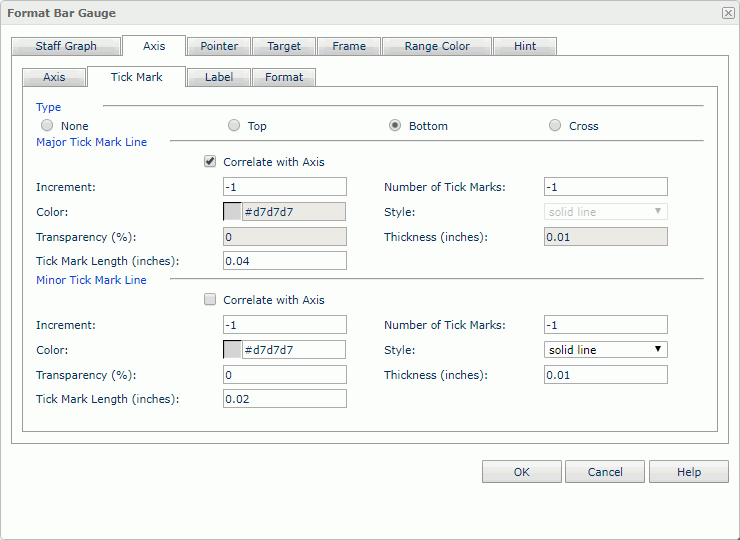
Type
Specifies the position relationship of the axis and the tick marks. When Layout is set to horizontal in the Staff Graph tab, the following are available:
- None
Specifies not to display the tick marks on the axis. It's meaningless to specify all the other tick mark related properties if this type is selected. - Top
Specifies to display the tick marks on the top of the axis. - Bottom
Specifies to display the tick marks on the bottom of the axis. - Center
Specifies to display the tick marks in the center of the axis.
When Layout is set to vertical in the Staff Graph tab, the following are available:
- None
Specifies not to display the tick marks on the axis. It's meaningless to specify all the other tick mark related properties if this type is selected. - Left
Specifies to display the tick marks on the left of the axis. - Right
Specifies to display the tick marks on the right of the axis. - Center
Specifies to display the tick marks in the center of the axis.
Major Tick Mark Line
Specifies the properties of the major tick mark line.
- Correlate with Axis
If checked, the line properties of the major tick marks will correlate with that of the axis automatically.- Color
Specifies the color of the major tick mark line. Disabled when Use Range Color in the Axis sub tab is checked. - Style
Specifies the style of the major tick mark line. - Transparency
Specifies the color transparency of the major tick mark line. Disabled when Use Range Color in the Axis sub tab is checked. - Thickness
Specifies the thickness of the major tick mark line.
- Color
- Increment
Specifies the distance between two adjacent major tick marks on the axis. - Number of Tick Marks
Specifies how many major tick marks to be displayed on the axis. - Tick Mark Length
Specifies the length of the major tick mark line.
Minor Tick Mark Line
Specifies the properties of the minor tick mark line.
- Correlate with Axis
If checked, the line properties of the minor tick marks will correlate with that of the axis automatically.- Color
Specifies the color of the minor tick mark line. Disabled when Use Range Color in the Axis sub tab is checked. - Style
Specifies the style of the minor tick mark line. - Transparency
Specifies the color transparency of the minor tick mark line. Disabled when Use Range Color in the Axis sub tab is checked. - Thickness
Specifies the thickness of the minor tick mark line.
- Color
- Increment
Specifies the distance between two adjacent minor tick marks on the axis. - Number of Tick Marks
Specifies how many minor tick marks to be displayed on the axis. - Tick Mark Length
Specifies the length of the minor tick mark line.
Label
Specifies the properties of the major tick mark labels.

Option
Specifies the type of the labels.
- None
If selected, the labels will not be shown. - Normal
If selected, the labels will be shown as you specify.- Label Every N Major Tick Marks
Specifies the frequency at which the major tick marks will be labeled. - Number of Major Labels
Specifies how many major tick mark labels to be displayed on the axis.- Auto
If checked, all major tick mark labels will be shown. - Fixed
If checked, you can specify the number of the major tick mark labels to be displayed on the axis.
- Auto
- Label Every N Major Tick Marks
- Range Value
If selected, the labels will show the range values.
Gap
Specifies the gap properties for the data labels.
- Label Axis Gap
Specifies the distance between the data labels and the axis, in inches. - Best Effect
Specifies whether to adjust the data labels automatically to make them placed best. If checked, some labels will be hidden when they are overlapped.
Font
Specifies the font format of text in the data labels.
- Font
Lists all the available font faces that can be selected to apply to the text. - Size
Specifies the font size of the text. - Fill Type
Specifies the fill type of the text. It can be one of the following: none, color, texture and gradient. - Color
Specifies the font color of the text. Disabled when Use Range Color in the Axis sub tab is checked. - Font Style
Specifies the font style of the text. It can be one of the following: plain, bold, italic, and bold italic. - Transparency
Specifies the color transparency of the text. Disabled when Use Range Color in the Axis sub tab is checked.
Orientation
- Angle
Specifies the rotation angle of the data labels.
Format
Specifies the data format of the major tick mark labels.
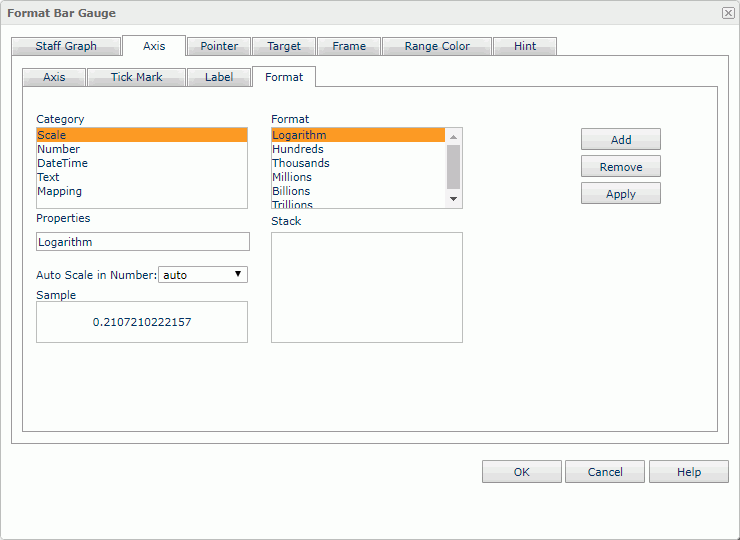
Category
Lists the category types. Select one to customize its format.
Format
Displays all the formats of the selected category. Select the required one and select Add to add it as the format of the specified category. You can add only one format for each category.
Properties
Displays the properties of the format you select. If the formats listed in the Format box cannot meet your requirement, define the format in the text box and then select Add to add it as the format of the specified category.
Auto Scale in Number
Specifies whether to automatically scale the major tick mark labels that are of the Number data type when the label values fall into the two ranges:
- When 1000 <= value < 10^15, the following quantity unit symbols of the International System of Units are used to scale the values: K (10^3), M (10^6), G (10^9), and T (10^12).
- When 0 < value < 0.001 or value >= 10^15, scientific notation is used to scale the values.
By default it is set to auto which means that the setting follows that of the chart platform. When it is true, the specified format applies to the integer part of the values after scaled, but if the specified format conflicts with Auto Scale in Number, for example, the values are displayed in percentage, then the Auto Scale in Number setting is ignored.
Sample
Displays a preview sample of your selection.
Stack
Lists all the formats you select from different categories.
Add
Adds a format to the Stack list box.
Remove
Removes a format from the Stack list box.
Apply
Applies the specified format in the Stack list box to the major tick mark labels.
Pointer
Specifies the properties of the pointers in the bar gauge.
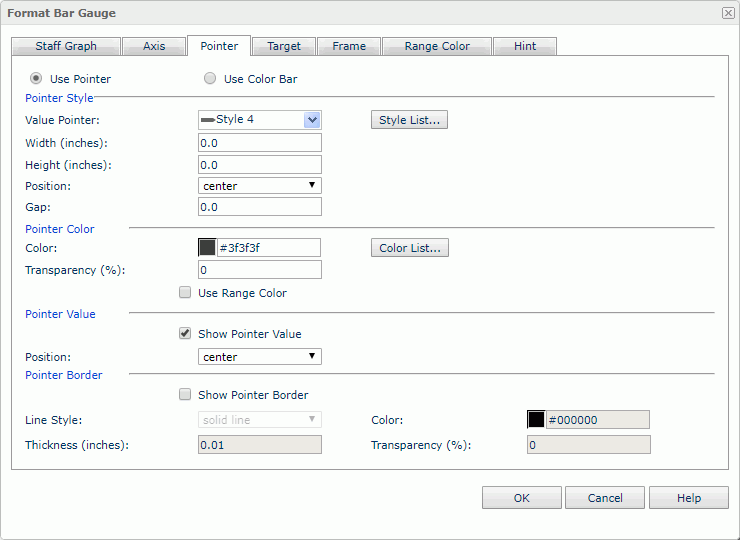
Use Pointer
Specifies to use pointers to indicate values in the bar gauge.
- Pointer Style
Specifies properties of the pointers.- Value Pointer
Specifies the style of the value pointers. Select a style from the drop-down list or select Customized to specify another image as the value pointers in the Insert Image dialog. - Width
Specifies the width of the pointers. - Height
Specifies the height of the pointers. - Position
Specifies the position of the pointers relative to the bar. - Gap
Specifies the distance between the pointers and the bar. - Style List
Opens the Style List dialog to specify the style for pointers in the same data series respectively.
- Value Pointer
- Pointer Color
Specifies color properties of the pointers.- Color
Specifies the color of the pointers. - Color List
Opens the Color List dialog to specify the color pattern for pointers in the same data series respectively. - Transparency
Specifies the transparency for color of the pointers. - Use Range Color
Specifies whether to use the color defined for the ranges as the pointer color. If checked, the three properties above will be disabled.
- Color
- Pointer Value
Specifies properties for values of the pointers.- Show Pointer Value
Specifies whether to show values for the pointers.- Position
Specifies the position relationship between the values and the pointers. Select the position from the drop-down list. If customized is selected, the X and Y settings in the General tab of the Format Pointer Label dialog will take effect.
- Position
- Show Pointer Value
Use Color Bar
Specifies to use color bars to indicate values in the bar gauge.
- Pointer Color
Specifies the properties of the color bars.- Color
Specifies the color of the bars. - Transparency
Specifies the transparency for color of the bars. - Thickness
Specifies the thickness of the color bars. - Color List
Opens the Color List dialog to specify the color pattern for color bars in the same data series respectively.
- Color
- Pointer Value
Specifies properties for values of the color bars.- Show Pointer Value
Specifies whether to show values for the color bars. - Position
Specifies the position relationship between the values and the color bars. Select the position from the drop-down list. If customized is selected, the X and Y settings in the General tab of the Format Pointer Label dialog will take effect.
- Show Pointer Value
Pointer Border
Specifies properties of the pointer border.
- Show Pointer Border
Specifies whether to show the border of the pointers. When it is checked, the following border properties are enabled.- Line Style
Specifies the line style to apply to the border. - Color
Specifies the color of the border. - Thickness
Specifies the weight of the border, in inches. - Transparency
Specifies the transparency for color of the border.
- Line Style
Target
Specifies the properties of the target in the bar gauge.
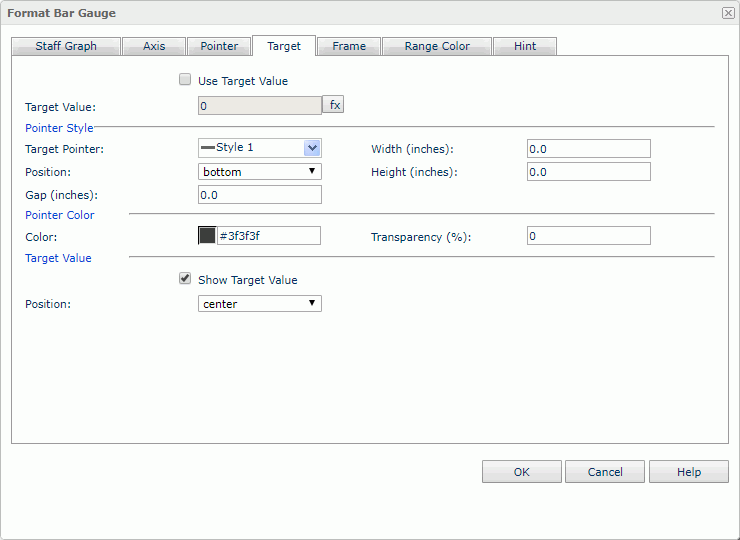
Use Target Value
Specifies whether to use the target value for the bar gauge.
- Target Value
Specifies the target value.
Pointer Style
Specifies the pointer style for the target value.
- Target Pointer
Specifies the style of the target pointer. Select a style from the drop-down list or select Customized to specify another image as the target pointer in the Insert Image dialog. - Width
Specifies the width of the target pointer. - Height
Specifies the height of the target pointer. - Position
Specifies the position of the target pointer relative to the bar. - Gap
Specifies the distance between the target pointer and the bar.
Pointer Color
Specifies color properties of the target pointer.
- Color
Specifies the color of the target pointer. - Transparency
Specifies the transparency for color of the target pointer.
Target Value
Specifies the properties of the target value.
- Show Target Value
Specifies whether to show the target value on the bar gauge.- Position
Specifies the position of the target value relative to the bar. Select the position from the drop-down list. If customized is selected, the X and Y settings in the General tab of the Format Target Label dialog will take effect.
- Position
Frame
Specifies properties for the frame of the bar gauge chart.
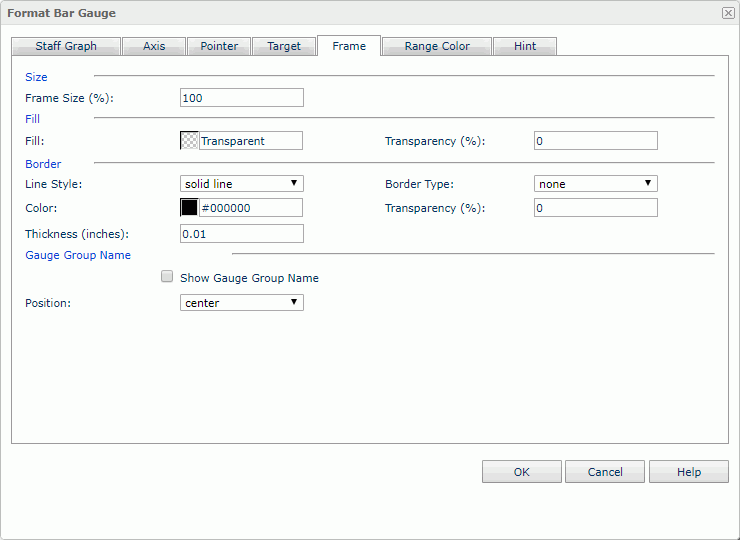
Size
Specifies the size properties of the frame.
- Frame Size
Specifies the size of the frame.
Fill
Specifies the color and transparency of the frame.
- Fill
Specifies the color to fill the frame. - Transparency
Specifies the transparency of the color to fill the frame.
Border
Specifies the properties for border of the frame.
- Line Style
Specifies the line style to apply to the border. - Border Type
Specifies the type of the border. - Color
Specifies the color of the border. To change the color, select the color indicator to specify a new color in the Select Color dialog, or input a color string in the format #RRGGBB. If you want to make the background transparent, input Transparent in the text box. - Transparency
Specifies the transparency for color of the border. - Thickness
Specifies the thickness of the border, in inches.
Gauge Group Name
Specifies properties for the gauge group name.
- Show Gauge Group Name
Specifies whether to show names for the bars in the bar gauge which are values of the field on its category axis. If the bar gauge contains no category field, the group name shows Report by default.- Position
Specifies the position of the names relative to the bars. Select the position from the drop-down list. If customized is selected, the X and Y settings in the General tab of the Format Gauge Label dialog will take effect.
- Position
Range Color
Specifies different colors to fill the bars in bar gauge in different ranges.
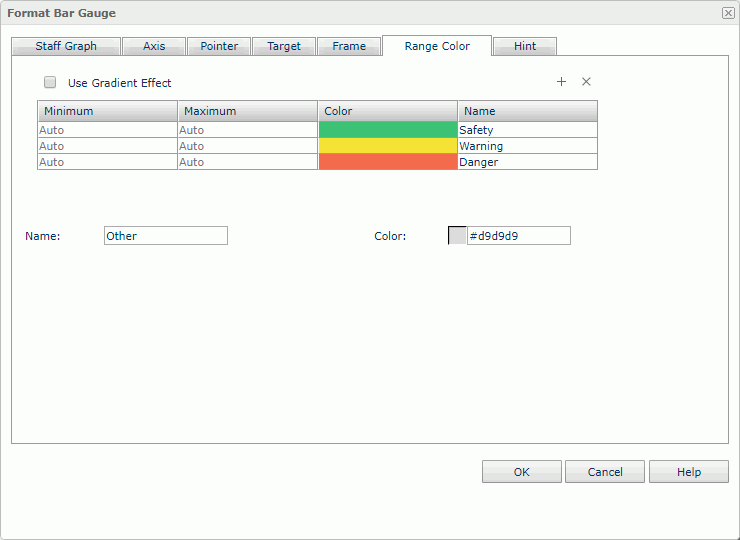
Use Gradient Effect
Specifies whether to use gradient effect for the color.

Adds a new color range.

Removes the selected color range.
Minimum
Specifies the minimum value of the range.
Maximum
Specifies the maximum value of the range.
Color
Specifies the color schema of the range. Select in the color cell to specify a new color in the Select Color dialog.
Name
Displays the name of the range.
Others
Specifies the properties for values that do not fall into any of the ranges you define.
- Name
Specifies the name for the values. - Color
Specifies the color for the values. To change the color, select the color indicator to specify a new color in the Select Color dialog, or input a color string in the format #RRGGBB. If you want to make the background transparent, input Transparent in the text box.
Hint
Specifies properties of the data marker hint.
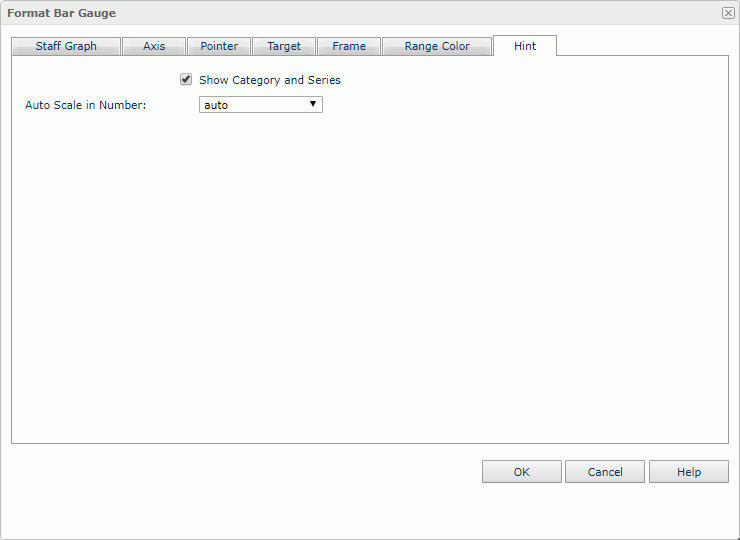
Show Category and Series
Specifies whether to include the category and series values in the data marker hint.
Auto Scale in Number
Specifies whether to automatically scale the values displayed in the data marker hint that are of the Number data type when the values fall into the two ranges:
- When 1000 <= value < 10^15, the following quantity unit symbols of the International System of Units are used to scale the values: K (10^3), M (10^6), G (10^9), and T (10^12).
- When 0 < value < 0.001 or value >= 10^15, scientific notation is used to scale the values.
By default it is set to auto which means that the setting follows that of the chart platform.
 Previous Topic
Previous Topic